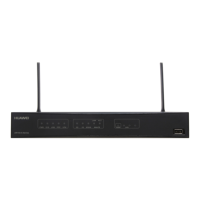The system view is displayed.
2. Run:
info-center source { module-name | default } channel { channel-number | channel-
name } [ trap { state { off | on } | level severity }
*
]
Alarms are added to the information channel.
For the specific modules, the default configurations are as follows:
For the log information, the state is on and the allowed information level is warning.
For the alarm information, the state is on and the allowed information level is
debugging.
For the debugging information, the state is off.
Step 2 Configure the channel through which alarms are output to the alarm buffer.
1. Run:
info-center trapbuffer [ channel { channel-number | channel-name } ]
The alarm buffer is set to receive information.
2. Run:
(optional)info-center trapbuffer [ channel { channel-number | channel-name }
| size buffersize ]
*
The channel through which alarms are output to the alarm buffer is configured.
After the information center is enabled, alarms default to be output through Channel 3 to
the alarm buffer and the alarm buffer can contain 256 pieces of information.
----End
2.4.5 Outputting Alarms to the Log File
When a fault occurs on the device, you can analyze the output alarms to provide references for
fault location.
Context
Do as follows on the router configured with the information center:
Procedure
Step 1 Send logs to the channel.
1. Run:
system-view
The system view is displayed.
2. Run:
info-center source { module-name | default } channel { channel-number | channel-
name } [ trap { state { off | on } | level severity }
*
]
Alarms are added to the information channel.
For the specific modules, the default configurations are as follows:
For the log information, the state is on and the allowed information level is warning.
Huawei AR150&200 Series Enterprise Routers
Configuration Guide - Device Management 2 Information Center Configuration
Issue 02 (2012-03-30) Huawei Proprietary and Confidential
Copyright © Huawei Technologies Co., Ltd.
23

